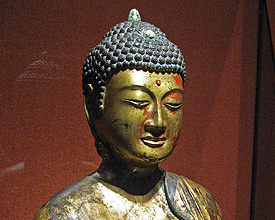
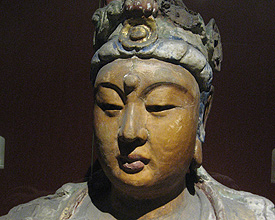
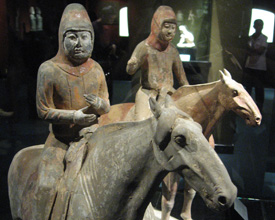
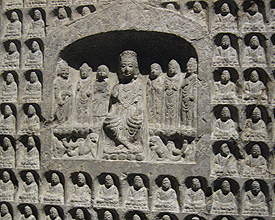
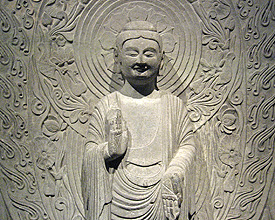
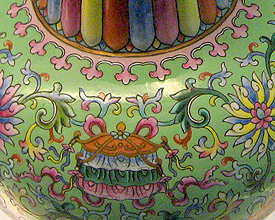
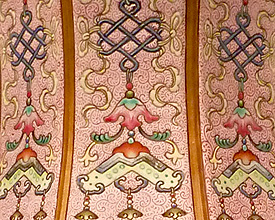
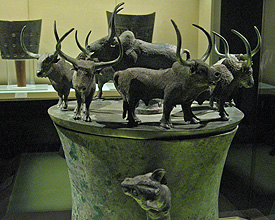
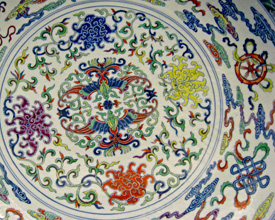
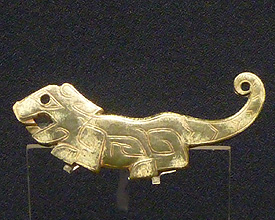
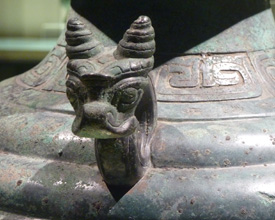
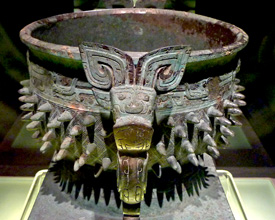
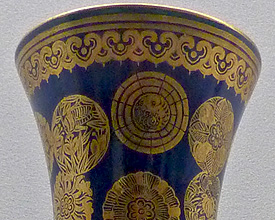
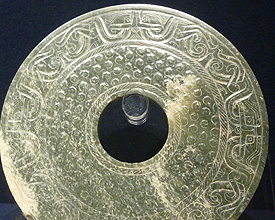
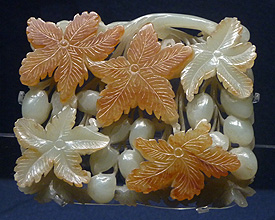
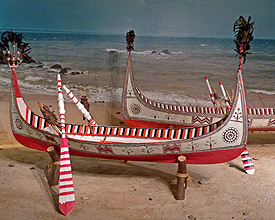
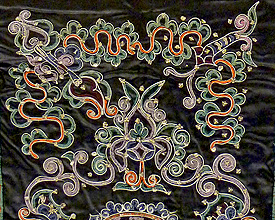
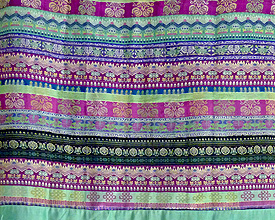
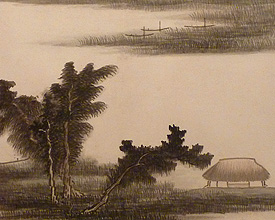
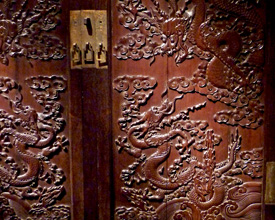

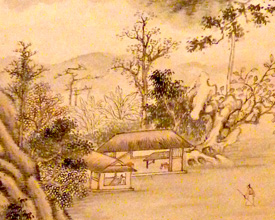
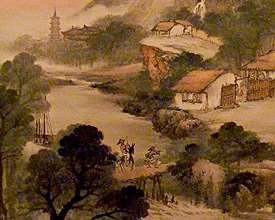
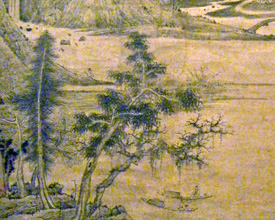
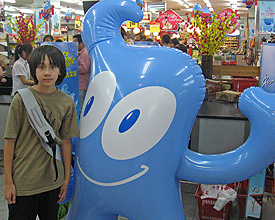
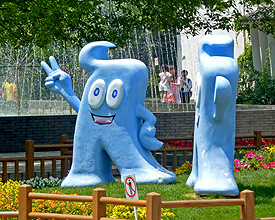
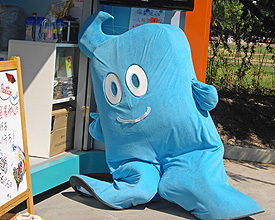
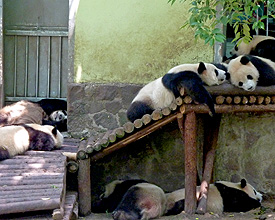
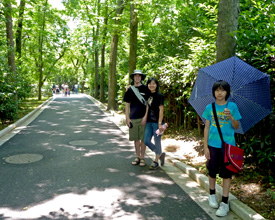
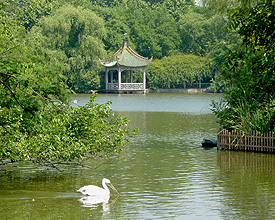
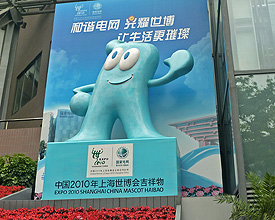
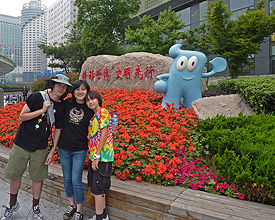
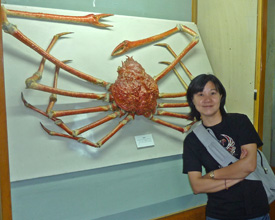
Hadley-Ives Summer 2010. Page 2. |
|
Page 2 features photographs from Shanghai, especially the Shanghai Museum.
|
 |
 |
 |
|
| A gilt bronze statue of the Mahavairocana Buddha made in the Dali Kingdom (大理國) during the second year of the Shengming Reign (1044 A.D., or maybe 1163 A.D.), In Shanghai Museum. |
A painted wooden sculpture of a Bodhisattva created by an artist during the Song Dynasty (960-1279). |
The Tang Dynasty (618-907) was a time when painted pottery statues such as these horsemen were produced in great numbers. |
|
 |
 |
 |
|
| A sixth century Buddhist stone stele. |
A Buddhist stone stele created during the Northern Qi, circa 550-577. |
This Tibetan vase made during the reign of the Chinese Qing Emperor Qianlong (1736-1795) uses a powdery color (fencai) enamel overglaze, and has eight auspicious Buddhist symbols. |
|
 |
 |
 |
|
| A powdery-color (fencai) vase. The larger image shows the main theme of this vase, which is the eight immortals. This is also an example of Jingdezhen ware (景德镇陶瓷), and this particular vase was produced during the long and prosperous reign of Qianlong (1736-1795) |
The Shanghai Museum calls this an "eight yak cowrie shell container," which suggests it was a sort of piggy bank when cowrie shells were used as currency. It dates from the Han Dynasty (the Western Han Dynasty of 206 B.C. to 8 A.D.). |
A Jingdezhen ware plate from the time of the Emperor Qianlong (1736-1795) using the technique of contrasting colors (doucai). This dish uses a design featuring two phoenixes and eight Buddhist emblems. (These are the right-coiled white conch, the precious umbrella, the victory banner, the golden fish, the dharma wheel, the auspicious knot, the lotus flower, and the vase of treasure. |
|
 |
 |
 |
|
| A tiger made in the late Shang Dynasty, around the 13th to 11th century B.C. |
An ancient bronze wine vessel with a dragon handle, probably made around 1000 B.C. to 1100 B.C., around the time of Moses. |
A 3,000+ year old food container cast in bronze in ancient China during the early Zhou Dynasty. |
|
 |
 |
 |
|
| Blue glazed vase with golden medallion design made during the reign of the Qing Emperor Guangzu, who ruled under his aunt's watchful control from 1875-1908. |
A jade disk from the Warring States period (476-221 BCE). This one has designs of animals and grains. |
This jade ornament from the time of the Jin Dynasty (1115-1234 A.D.) has a design of grapes and grape leaves. |
|
 |
 |
 |
|
| The beautiful boats of the Tao People of Orchid Island. |
Baby carrier with horsehair embroidery, from someone of the Shui nationality in Sandu, Guizhou. This was done in the second half of the 20th century. |
This is part of a woman's outfit from the Dai culture. This is from Xishuangbanna, Yunnan province, and it dates from the first half of the 20th century. |
|
 |
 |
 |
|
| One of Gong Xian's (1618-1689) ink and watercolor landscapes. This one dates from 1684. Gong Xian was one of the Nanjing Masters. |
Example of wooden furnture with dragon designs. This one dates to the middle-Qing dynasty, in the 18th century, probably during the reign of Qianlong. |
The Shanghai Museum has some rooms furnished with antique furniture and set up like typical rooms of the 17th, 18th, and 19th centuries. |
|
 |
 |
 |
|
| Reading in the Autumn Woods, a landscape by Tang Yifen (1778-1853), who created this work in 1846. |
Autumn Mountains in Sunset Glow, a landscape by Wu Qingyun, an artist who lived until 1916. |
Boating in the Stream and Mountains, a landscape by Cao Zhibai (1272-1355), an accomplished artist of the Yuan dynasty who also collected books. |
|
 |
 |
 |
|
| Haibao was everywhere in Shanghai. Here he is being friendly with Arthur. |
Haibao hanging out at the Shanghai Zoo. The sign in front warns people not to approach too closely, as this incarnation of Haibao isn't so cuddly. |
This was a Haibao costume, but it was too hot for anyone to wear it, so it sat here as if Haibao was exhausted after a tour of the zoo. |
|
 |
 |
 |
|
| The pandas receive many visitors in the Shanghai zoo, but if you come around the middle of the day they will probably be resting. | We spent a few hours enjoying the Shanghai Zoo. It's a large zoo, and very popular on weekends. | The Shanghai Zoo is one of the nicest places to go to enjoy gardens and landscaping. Here is a view of a lake in the park. |
|
 |
 |
 |
|
| Haibao seems to be everywhere. | Here is Haibao standing amid some flowers in downtown Shanghai. | Jeri admires the size of this crab in the Shanghai Natural History Museum. |
Hadley-Ives homepage.
|
|
|